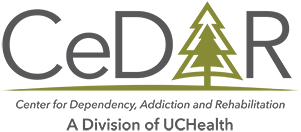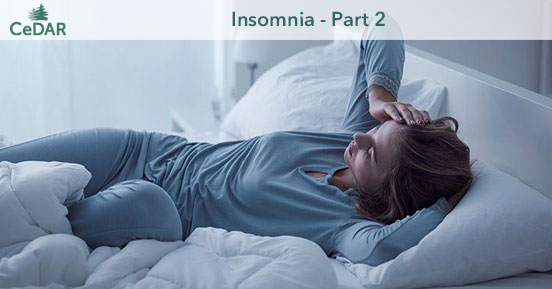ADDICTION SCIENCE
Sleep: Part 2 of 3
Our first article delving deeper into the science of sleep emphasized the biological layers to the sleep cycle, including stages of sleep and the ways in which substances can interfere with sleep quality. Active addiction can alter sleep cycles, even into early recovery. Therefore, CeDAR treatment often involves helping people restore their sleep. Chronic insomnia is also a very common reported reason for someone relapsing on substances. The stress and agitation from poor sleep eventually wear someone down. Insomnia is difficulty falling or staying asleep despite a person having the opportunity and desire to sleep. We separate insomnia into three overall periods: early, mid and late-insomnia. Early insomnia is difficulty falling asleep during the first parts of the evening. Mid-insomnia involves periods of disruption and waking through the night. Late-insomnia is the pattern of waking earlier in the morning than desired, with the inability to return to sleep. Our patients often struggle with each of these issues. Identifying the characteristics of a person’s insomnia can help us better understand the core issues at play.
Early Insomnia
Early insomnia is commonly associated with disruptions in the sleep/wake cycle, stimuli in the body such as caffeine or other substances, or some psychiatric issues such as anxiety or bipolar disorder. For people who feel ‘wired’ around bedtime or experience racing thoughts, they can find it nearly impossible to drift off into dreamland. Prescribed medications assist many of our patients with sleep. These pharmacologic approaches address early insomnia by making the person drowsy. In this way, the treatment approach causes sleep, but may not improve either sleep quality or total length of sleep time.
Mid-Insomnia
Mid-insomnia is very common for those recovering from alcoholism or drug addiction. The overall disruption in the brain’s sleep architecture requires a prolonged healing process – for some, up to one year out from the last drink. Mid-insomnia is also a way of describing someone who falls asleep but experiences generally poor sleep quality. The brain is not progressing deep into the stages of sleep, including REM sleep, and the person never feels rested. It is important to acknowledge that normal sleep patterns will involve brief periods of waking through the night. For the pattern to have a definition of insomnia, it will take the person at least 30 minutes to fall back asleep during these wakeful periods.
Late Insomnia
Late insomnia can be a highly frustrating experience for some people, as they do not feel completely rested and yet have woken up early in the morning. Some individuals may wake up around 3 or 4 o’clock despite setting their alarm for 6 or 7. They will then lie within their thoughts which may include agitation or worries. From a psychiatric perspective, late-insomnia is very common for those struggling with Major Depressive Disorder. Through conducting a detailed screen of someone’s insomnia, we may be able to determine the status of someone’s mental health needs such as depression. By providing treatment and resolving the depression, the late-insomnia is likely to heal.
Sleep Medications
Medications which promote sleep are some of the most commonly prescribed pills, as insomnia tends to be part of so many different behavioral health problems. These medications are primarily used to address early insomnia, as they act relatively quickly and help induce sleep. The most common neurotransmitter pathways involved in this effect are histamine and GABA. It is important to distinguish these modes of action, especially when treating patients with addictive disorders. Sleep medications which function through antihistamine activity are not habit-forming, whereas GABA-based medications can be highly addictive.1
Trazodone
The medication Trazodone was initially designed to treat depression and is in the unique class of being a Serotonin-2 antagonist and Serotonin reuptake inhibitor. It was found to be generally weak at resolving depression and is therefore rarely used as a primary antidepressant. Its antihistamine properties are strong, however, giving Trazodone its small niche in treating insomnia both effectively and safely. Trazodone has a wide range of dosing, between 50 and 200mg each night. It typically acts within 1-2 hours of dosing. The most common side effects experienced include vivid dreams and a morning headache. Rare side effects include the occurrence of priapism, which is a penile erection which may last for many hours and can require emergency medical treatment.
Seroquel
Seroquel (generic name: Quetiapine) is a complex medication, initially designed to treat severe mental illness including Bipolar Disorder and Schizophrenia. It is an antipsychotic medication, acting as a dopamine modulator in the brain. It also has some activity involving serotonin which may contribute to its antidepressant effects. The insomnia benefit from Seroquel is also through its antihistamine properties. Because of its complexity, Seroquel has multiple potential side effects. These include metabolic effects such as weight gain, increased cholesterol, and the potential for developing diabetes. It can cause low blood pressure and has a rare risk for causing a dangerous fever. There has been a mild concern for patients to abuse Seroquel as a sedative medication, but this seems to be more prevalent in the jail system, where other drugs of abuse are difficult to obtain. Drug Enforcement Administration (DEA) does not consider Seroquel a controlled substance. Common dosing for Seroquel is either 50 or 100mg each night. To lessen the risk for weight gain or the other metabolic effects, we often recommend using this medication for insomnia for a brief period of time. For patients with concurrent mental illness issues such as Bipolar Disorder, Seroquel can be a very useful insomnia medication.
Ambien
A class of medications often used for sleep is the “Z-Drugs.” This includes Ambien (generic name: Zolpidem) which has activity similar to benzodiazepines. Because of the similar activity on the GABA system, Ambien acts quickly and effectively for sleep, but the person often builds a tolerance to its effects. With regular use, Ambien can be reinforcing. It is for these reasons that Ambien is classified as a controlled substance by the DEA. There is a controlled-release version of Ambien which can be helpful for people struggling with the mid-insomnia as discussed above. This medication delivers a gradual dose through the night and can help induce sleep along with helping someone stay asleep.
Dangerous Effects of Ambien
Ambien also has potentially dangerous effects in the form of bizarre amnesia after taking a dose. Many people have heard terrifying stories of a person ingesting an Ambien and then driving across town in a blackout state. Other more common examples include binge eating or making strange phone calls to a friend while on Ambien. For someone in early recovery, we regularly recommend against the use of Ambien for sleep. Although powerful in addressing early insomnia, the benefits likely do not outweigh the risks. This is especially true for someone diagnosed with Post-Traumatic Stress Disorder. Insomnia is incredibly common with this condition, However, the dissociative properties of Ambien are hinder our efforts to help people cope with reality as it is instead of falling back on repeated themes of avoidance.
Remeron
Developed as an antidepressant similar to Trazodone was Rameron (Generic name: Mirtazapine). Unlike Trazodone, however, it causes a good effect in lifting symptoms of depression and anxiety. It is commonly used as an add-on medication for depression treatment taken concurrently with some other antidepressants. Remeron’s side effects include sleepiness (hence its use to help facilitate early insomnia) and weight gain. It is ideally used to help someone who has terrible insomnia and is underweight. In this way, the side effects can be desirable within the overall goals of treatment.
Summary
We use certain medications to help facilitate better sleep, specifically ones that impact histamine or GABA. These approaches tend to treat early insomnia or the difficulty in falling asleep. It is our job as clinicians to help deepen the discussion with someone about their struggle with insomnia, as this helps us tailor appropriate treatment for them. Our next article on the topic of sleep will focus on the therapeutic interventions available to treat insomnia, specifically the evidence-based protocol of Cognitive Behavioral Therapy for Insomnia (CBT-I). When we combine effective and safe medication approaches with advanced therapy techniques, sleep quality can markedly improve, as can someone’s overall recovery and wellness. Read more CeDAR Education Articles about Addiction Science1




